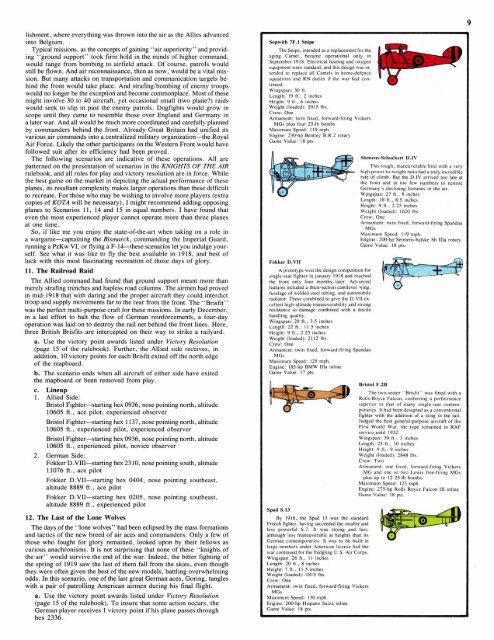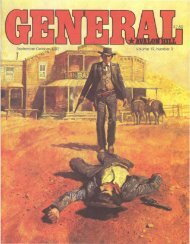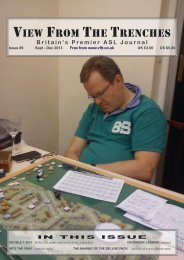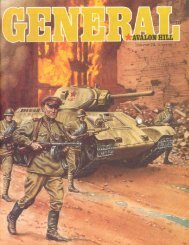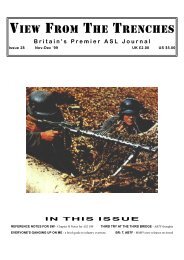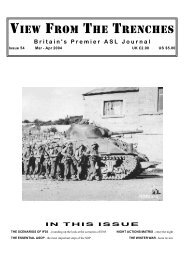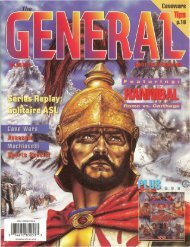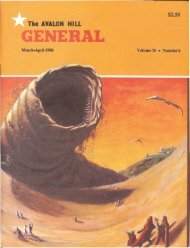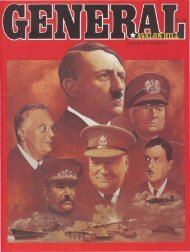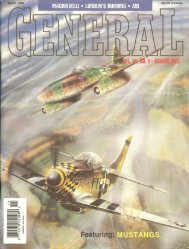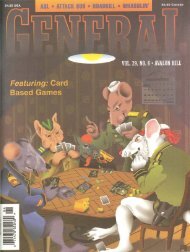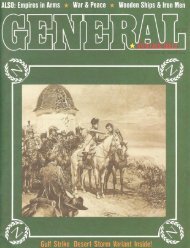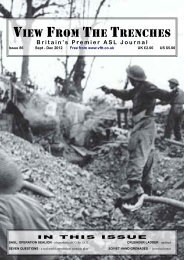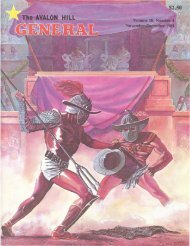18.64MB - View From The Trenches
18.64MB - View From The Trenches
18.64MB - View From The Trenches
- TAGS
- trenches
- www.vftt.co.uk
You also want an ePaper? Increase the reach of your titles
YUMPU automatically turns print PDFs into web optimized ePapers that Google loves.
lishment, where everything was thrown into the air as the Allies advanced<br />
into Belgium.<br />
Typical missions, as the concepts of gaining "air superiority" and providing<br />
"ground support" took firm hold in the mlnds of higher command,<br />
would range from bombing to airfield attack. Of course, patrols would<br />
still be flown. And air reconnaissance, then as now, would be a vital mission.<br />
But many attacks on transportation and communication targets behind<br />
the front would take place. And strafinglbombing of enemy troops<br />
would no longer be the exception and become commonplace. Most of these<br />
might involve 30 to 40 aircraft, yet occasional small (two plane?) raids<br />
would seek to slip in past the enemy patrols. Dogfights would grow in<br />
scope until they came to resemble those over England and Germany in<br />
a later war. And all would be much more coordinated and carefully planned<br />
by commanders behind the front. Already Great Britain had unified its<br />
various air commands into a centralized military organization-the Royal<br />
Air Force. Likely the other participants on the Western Front would have<br />
followed suit after its efficiency had been proved.<br />
<strong>The</strong> following scenarios are indicative of these operations. All are<br />
patterned on the presentation of scenarios in the KNIGHTS OF THE AIR<br />
rulebook, and all rules for play and victory resolution are in force. While<br />
the best game on the market in depicting the actual performance of these<br />
planes, its resultant complexity makes larger operations than these difficult<br />
to recreate. For those who may be wishing to involve more players (extra<br />
copies of KOTA will be necessary), I might recommend adding opposing<br />
planes to Scenarios 11, 14 and 15 in equal numbers. I have found that<br />
even the most experienced player cannot operate more than three planes<br />
at one time.<br />
So, if like me you enjoy the state-of-the-art when taking on a role in<br />
a wargame-captaining the Bismarck, commanding the Imperial Guard,<br />
running a PzKw VI, or flying a F-14-these scenarios let you indulge yourself.<br />
See what it was like to fly the best available in 1918, and best of<br />
luck with this most fascinating recreation of those days of glory.<br />
11. <strong>The</strong> Railroad Raid<br />
<strong>The</strong> Allied command had found that ground support meant more than<br />
merely strafing trenches and hapless road columns. <strong>The</strong> airmen had proved<br />
in mid-1918 that with daring and the proper aircraft they could interdict<br />
troop and supply movements far to the rear from the front. <strong>The</strong> "Brisfit"<br />
was the perfect multi-purpose craft for these missions. In early December,<br />
in a last effort to halt the flow of German reinforcements, a four-day<br />
operation was laid on to destroy the rail net behind the front lines. Here,<br />
three British Brisfits are intercepted on their way to strike a railyard.<br />
a. Use the victory point awards l~sted under Victory Resolution<br />
(page 15 of the rulebook). Further, the Allied side receives, in<br />
addition, 10 victory points for each Brisfit exited off the north edge<br />
of the mapboard.<br />
b. <strong>The</strong> scenario ends when all aircraft of either side have exlted<br />
the mapboard or been removed from play.<br />
c. Lineup<br />
1. Allied Side:<br />
Bristol Fighter-starting hex 0936, nose pointing north, altitude<br />
10605 ft., ace pilot, experienced observer<br />
Bristol Fighter-starting hex 1137, nose pointing north, altitude<br />
10605 ft., experienced pilot, experienced observer<br />
Bristol Fighter-starting hex 0936, nose poinhng north, altitude<br />
10605 ft., experienced pilot, novice observer<br />
2. German Side:<br />
Fokker D.VIII-starting hex 23 10, nose pointing south, altitude<br />
1 1076 ft . , ace pilot<br />
Fokker D.VII-starting hex 0404, nose pointing southeast,<br />
altitude 8889 ft., ace pilot<br />
Fokker D.VII-starting hex 0205, nose pointing southeast,<br />
altitude 8889 ft., experienced pilot<br />
12. <strong>The</strong> Last of the Lone Wolves<br />
<strong>The</strong> days of the "lone wolves" had been eclipsed by the mass formations<br />
and tactics of the new breed of air aces and commanders. Only a few of<br />
those who fought for glory remained, looked upon by their fellows as<br />
curious anachronisms. It is not surprising that none of these "knights of<br />
the air" would survive the end of the war. Indeed, the bitter fighting of<br />
the spring of 1919 saw the last of them fall from the skies, even though<br />
they were often given the best of the new models, battling overwhelming<br />
odds. In this scenario, one of the last great German aces, Goring, tangles<br />
with a pair of patrolling American airmen during his final flight.<br />
a. Use the victory point awards listed under Victory Resolution<br />
(page 15 of the rulebook). To insure that some action occurs, the<br />
German player receives 1 victory point if his plane passes through<br />
hex 2336.<br />
Sopwith 7F.1 Snipe<br />
<strong>The</strong> Snipe, mended as a replacement for the ' '<br />
aging Camel, became operational only in<br />
September 1918. Electrical heating and oxygen<br />
rp'<br />
equipment were standard, and th~s design was in-<br />
T-<br />
tended to replace all Camels in home-defence<br />
squadrons and RN duties if the war had continued.<br />
Wingspan: 30 ft<br />
Length: 19 ft.. 2 inches<br />
Height: 9 ft.. 6 tnches<br />
Weight (loaded): 2015 Ibs.<br />
Crew: One<br />
Armament: twin fixed, fonvard-firing Vickers<br />
MGs plus four 25-lb bombs<br />
Maximum Speed: 119 mph.<br />
Engine: 230-hp Bentley B.R.2 rotary<br />
Game Value: 18 pis.<br />
Siemens-Schuckert D.IV<br />
This tough, maneuverable bird with a very<br />
h~gh power-to-weight ratlo had a truly tncredible<br />
rate of climb. But the D.IV arrived too late at<br />
the front and in tw few numbers to restore<br />
Germany's declining fortunes in the air.<br />
Wingspan: 27 ft., 5 inches<br />
Length: 18 ft., 8.5 inches<br />
Height: 9 ft., 2.25 inches<br />
Weight (loaded): 1620 Ibs.<br />
Crew: One<br />
Armament: twln fixed, forward-firing Spandau<br />
MGs<br />
Maximum Speed: 119 mph.<br />
Engine: 200-hp Seimens-halske Sh IIIa rotary<br />
Game Value: 18 pts.<br />
Fokker D.VII<br />
A prototype won the design competition for<br />
stngle-seat fighter in january 1918 and reached<br />
the front only four months later. Advanced<br />
features included a thick-sect~on cantilever wing,<br />
fuselage of welded steel tubing, and automobile<br />
radiator. <strong>The</strong>se combined to give the D.VII excellent<br />
htgh-altitude maneuverability and strong<br />
resistance to damage combined with a docile<br />
handling quality.<br />
Wingspan: 29 ft., 3.5 inches<br />
Length: 22 ft., 11.5 inches<br />
Height: 9 ft., 2.25 inches<br />
Weight (loaded): 21 12 Ibs.<br />
Crew: One<br />
Armament: twin fixed, forward-firing Spandau<br />
MGs<br />
Maximum Speed: 125 mph.<br />
Engine: 185-hp BMW llla inline<br />
Game Value: 17 pts.<br />
I----<br />
Bristol F.2B<br />
<strong>The</strong> two-seater "Brisfit" was fitted with a<br />
Rolls-Royce Falcon, conferring a performance<br />
-<br />
superior to that of many single-seat contem-<br />
C<br />
poraries. It had been designed as a conventional<br />
tighter with the additton of a sting in the tail.<br />
Judged the best general-purpose aircraft of the<br />
First World War, the type remained in RAF<br />
service until 1932.<br />
Wingspan: 39 ft., 3 inches<br />
Length: 25 ft., 10 inches<br />
Height: 9 ft., 9 inches<br />
Weight (loaded): 2848 Ibs.<br />
Crew: Two<br />
Armament: one fixed, forward-firing Vickers<br />
MG and one or two Lewis free-firing MGs<br />
plus up to 12 25-lb bombs<br />
Maximum Speed: 123 mph.<br />
Engine: 275-hp Rolls Royce Falcon I11 inline<br />
Game Value: 18 pts.<br />
Spad S.13<br />
By 1918, the Spad 13 was the standard ,<br />
French fighter, having succeeded the smaller and<br />
less powerful S.7. It was strong and fast,<br />
although less maneuverable at heights than its<br />
German contemporaries. It was to he built in<br />
large numbers under American license had the<br />
war continued for the fledgling U.S. Air Corps.<br />
Wingspan: 26 ft., 11 inches<br />
Length: 20 ft., 8 inches<br />
Height: 7 ft.. 11.5 inches<br />
Weight (loaded): 1815 Ibs.<br />
Crew: One<br />
Armament: twin fixed, forward-firing Vickers<br />
MGs<br />
Maxtmum Speed: 130 mph.<br />
Engine: 200-hp Hispano Suiza inline<br />
Game Value: 18 pts.<br />
. -<br />
&


